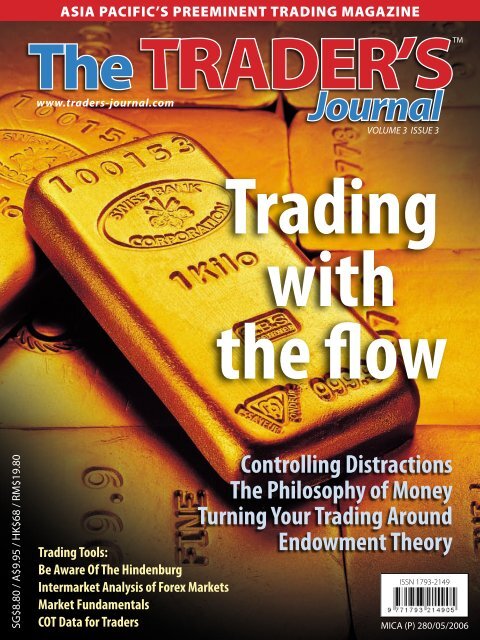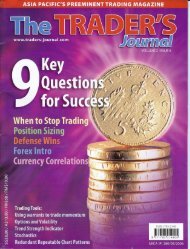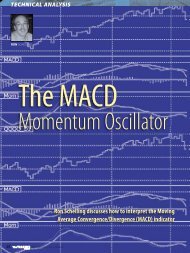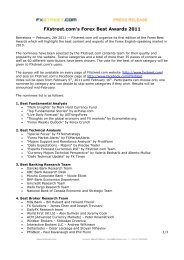Our article about FX-Quant (PDF) - 2hedge
Our article about FX-Quant (PDF) - 2hedge
Our article about FX-Quant (PDF) - 2hedge
Create successful ePaper yourself
Turn your PDF publications into a flip-book with our unique Google optimized e-Paper software.
ASIA PACIFIC’S PREEMINENT TRADING MAGAZINETMwww.traders-journal.comVOLUME 3 ISSUE 3Tradingwiththe flowSG$8.80 / A$9.95 / HK$68 / RM$19.80Trading Tools:Be Aware Of The HindenburgIntermarket Analysis of Forex MarketsMarket FundamentalsCOT Data for TradersControlling DistractionsThe Philosophy of MoneyTurning Your Trading AroundEndowment TheoryISSN 1793-2149MICA (P) 280/05/2006
FOREIGN EXCHANGERON SCHELLINGRon Schelling, private trader,reviews and discusses the <strong>FX</strong>-<strong>Quant</strong>trading system using quantitativeanalyses on Forex marketsForex Arbitrage Usingthe Currency BasketMARCH 2007 / VOLUME 3 ISSUE 357
FOREIGN EXCHANGEWhat does Arbitrage mean?Arbitrage is a financial operation in whichcurrency pairs are bought and sold, eithersimultaneously or in a minimum lapseof time, either in the same market or adifferent one, with the goal of obtaininga profit spread – a product of the rate’sprice differentials. Arbitrage, in its purestform, is defined as the purchase of securitieson one market for immediate resaleon another market in order to profit froma price discrepancy. This results in immediaterisk-free profit.Arbitrage, however, can take other formsas well. Unlike pure arbitrage, statisticalarbitrage (also called a pair trade or spreadtrade) does involve risk. Despite the disadvantagesin pure index arbitrage, statisticalarbitrage is still accessible to mostretail traders. Although this type of arbitragerequires taking on some risk, it isgenerally considered “playing the odds”.What is an Arbitrage Model?Arbitrage models for currency/stock pairsmay be designed in a variety of ways. Theimportant key is to have knowledge of therelationships among pairs.Statistical Arbitrage (Pairs)Trading SystemsIt is rarely in the best interests of investmentbankers and hedge fund managersto share profitable trading strategies withthe public, so the arbitrage remained asecret of the professionals and a few deftindividuals.Statistical Arbitrage: PairsTradingThis form of arbitrage relies on a strongcorrelation between two related securities.Pairs trading has the potential toachieve profits through simple and relativelylow-risk positions. The pairs tradeis market-neutral, meaning the directionof the overall market does not affect itswin or loss.What Is “Market-Neutral”?A market neutral strategy is one where atrader takes a long position and a shortposition at the same time. There are manyways of implementing this strategy butthe basic premise is the same: at any giventime some securities are overvalued andothers are undervalued. Once two marketsdetermined to be statistically “outof alignment”, a long position is taken inthe market considered to be undervaluedwhile a short position is simultaneouslytaken in the market considered to beovervalued relative to the first market.In this <strong>article</strong> I like to take a next step,review and discuss the <strong>FX</strong>-<strong>Quant</strong> tradingsystem using quantitative analyses on Forexmarkets.With most trading systems, monthly returnsare uncorrelated, i.e. a series of losingmonths does not improve the chancesfor profit in the coming months. With <strong>FX</strong><strong>Quant</strong>’s system, however, the losses makeground for future gains.Numerical simulations show that in longrun, and if reasonable leverage is used, theprofit factor of this system will be greaterthan unity (the sum of gains will alwaysbe greater than the sum of losses). Theleverage is carefully determined in orderto avoid disastrous draw downs.The objective is to achieve capital appreciationwith controlled draw downs. Thissophisticated and innovative methodologyis viable investment alternative forboth private and institutional investors,especially in today’s chaotic markets.It took some time within investmentcircles for currency to be recognized assomething where you can consistently addvalue. In currency markets, because whereverthere is a buyer there is a seller, manyhave said currency markets are a zero-sumgame. Also, as the currency market is themost liquid and largest financial marketin the world, it is a big ocean to feed in.This allows opportunities for our systemto extract value from inefficiencies in thecurrency markets and generate positivereturns.The <strong>FX</strong> <strong>Quant</strong>’s trading strategy is basedon quantitative analysis - a statistical concept.It is 50% statistical arbitrage statisticaland 50% position size management.Unlike most trading systems, which attemptto predict market direction, thistrading model reacts to price action andmakes trading decisions.Figure 1 – The StrategyDiversificationThe strategy creates a complex portfolioof 10 global currencies and adjusts itscomponents daily. The mathematics ofportfolio diversification show that whenyou combine weakly correlated currencypairs together, a higher information ratio(returns per unit of risk) is generatedthan with individual currencies. In otherwords, diversification of currencies canlead to better risk-rewards for the combinedportfolio.As an example, in a portfolio comprisedof three currency pairs, one position canbe unprofitable at the moment, but theother two can show profits to more thancompensate for the losses incurred withthe losing one.The system works with all currency pairs.The system is non-parametric, i.e. thereare no parameters to optimize, except theleverage. Hence, the system is very robustand does not depend on price patterns(which most trading systems depend on).The leverage is carefully determined in orderto avoid disastrous draw downs.Standard risk parameters employ an averagecombined leverage around 2.5:1 forthe entire portfolio. The historical maximumleverage was 5.9:1 and it lasted forless than 2 months. An important systemfeature is that leverage reverts/oscillatesaround a long term average. The best timeto start trading is when the actual leverageis above the average (long term) leverage.The leverage and the estimated riskis reported in the monthly performancereports.58 MARCH 2007 / VOLUME 3 ISSUE 3
FOREIGN EXCHANGErency units as needed to make the positionsize as per trading plan.For example, if the NZDUSD positionwas +11716 the day before (in a $10,000account), you should BUY ADDITION-AL 272 NZDUSD units in order to makeposition size +11988.Rebalancing PortfolioLet us assume our position (carried fromthe day before) is +11716 NZDUSD.If the current trading plan reads “+11988NZDUSD”, it means we should adjustthe NZDUSD position by +11988-(+11716) = +272 NZDUSD (buy 272NZDUSD units). In a $30,000 account(opening account balance) we should buy3×272 = 816 NZDUSD units.Trading ApproachThe trading system is based on mathematicalmodels, which are based onquantitative analysis, statistical arbitrageand position size management. Throughthese methods, trades currencies of developedcountries (EUR, GBP, CHF,CAD, JPY, AUD, NZD, SEK, DKK andNOK) in the spot markets and does nottrade futures or options on futures onany organized exchange. This programanalyses exchange rates between the currenciescomprising the basket. It givesspecific trading signals for each currency,which are then implemented against thesix remaining currencies. The resultingpositions are then implemented in themarket.It uses statistical methodology and notclassical fundamental or technical analysis.There are no classical indicators whichattempt to predict market direction (noone can predict market direction!), nopattern recognition techniques and notrading rules based on trader’s experience.The trading system is always in the market,but portfolio components are adjusteddaily. Leverage is applied in line withclient’s preferred risk tolerance level.Performance SummaryBe patient. Do not expect to make a fortuneover night - profit generation is avery slow process. Ideally, trading shouldbe started when a drawdown occur, orwhen current leverage is higher than averageleverage for the life of trading. Ifinterested, we can tell you what the besttime to start trading is. Unless you arepatient enough to trade for at least sixmonths, you should better not start tradingat all. Sometimes, the system quietlyaccumulates positions for months, beforethe profit explodes. This innovative tradingmodel does not attempt to time themarket. It doesn’t care where the marketmoves, but it extracts profits day in andday out.Figure 3 – Monthly ReportFigure 4 – Value Added Monthly IndexRon Schelling (1954) was born in The Netherlands and started as an Airtrafic controller in the Dutch Air Force followed by pilot training in the USA , flyingbusiness aircraft and teaching as a flight instructor in Europe and the USA. In 1983 he started commodity trading in Dallas, London and then back toHolland. He was also involved in Airline Lease Partnerships.Since his start in the financial world he has been active in technical analysis and trading systems using the discipline he had learned in aviation. Furtherhe advise several airlines on Forex and Jet Fuel Risk management. Today he trades a small private fund and several trading accounts, mostly using Spreadsand Aribitrage on Forex, Fututes and Stocks. He is a speaker in international technical analysis seminars and is the founder of the 2HEDGE Company -www.<strong>2hedge</strong>.com60 MARCH 2007 / VOLUME 3 ISSUE 3





